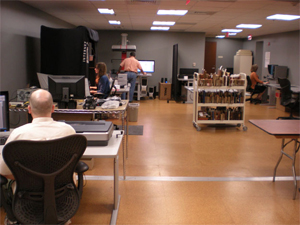 Rita Johnston, Digitization Assistant for ROAD 2.0 project has been with the department for one year. She is digitizing outdoor advertising materials described in the Resource of Outdoor Advertising Descriptions database. The bulk of materials being digitized for this project are from the OAAA Archives and OAAA Slide Library collections, but some images from the John Paver Papers and the John E. Brennan Survey Reports are also included.
Rita Johnston, Digitization Assistant for ROAD 2.0 project has been with the department for one year. She is digitizing outdoor advertising materials described in the Resource of Outdoor Advertising Descriptions database. The bulk of materials being digitized for this project are from the OAAA Archives and OAAA Slide Library collections, but some images from the John Paver Papers and the John E. Brennan Survey Reports are also included.
The project includes about 15,000 photographs and negatives which Rita has digitized, and I have about 12,000 slides which she has sent to a vendor for digitization. She uses different equipment including flatbed scanners and the Zeutschel 14000 A2 scanner for photographs and the Phase One Camera for transparent materials such as negatives. Rita is wrapping up the digitization phase of the project and will begin focusing her attention on normalization and cleanup of the metadata in the ROAD database.
When asked what is the most interesting collection you have worked with, Rita replied:
Since I have mostly been working with materials from the OAAA Archives, the OAAA Archives is the most interesting collection I have worked with. There is a great deal of variety in the content and types of materials in the collection. Much of the subject matter is of billboards, art designs, and other forms of outdoor advertising from the 1910s to the early 1980s.
The subject matter includes food & beverages, local businesses, political propaganda, cars, financial institutions, movies, and of course, beer and cigarettes. It’s really interesting to see how much billboards have changed over time, from the beautiful hand painted signs of the early to mid 20th century to machine printed billboards of later years.
 There are even a few interesting examples in the collection of cellulose acetate negatives breaking down. All negatives are prone to deterioration over time, and the process may be sped up if negatives are exposed to high heat and humidity. Some of the negatives smell strongly of vinegar and are warped and cracked where the emulsion is breaking down.
There are even a few interesting examples in the collection of cellulose acetate negatives breaking down. All negatives are prone to deterioration over time, and the process may be sped up if negatives are exposed to high heat and humidity. Some of the negatives smell strongly of vinegar and are warped and cracked where the emulsion is breaking down.
We are all eagerly awaiting Rita’s project to be online. Thanks Rita for all of your hard work!


 Continue reading the
Continue reading the  The latest issue of
The latest issue of 

 It’s Manuscript Day in the lab, similar to
It’s Manuscript Day in the lab, similar to  As you may know we have been working with the Digital Production Center to
As you may know we have been working with the Digital Production Center to 

 My favorite project over the years has been building the Digital Production Center. When I started on March 14, 2005, the Digital Production Center was located on Perkins lower level behind the copy room and was often used as a shortcut from the lower level to the
My favorite project over the years has been building the Digital Production Center. When I started on March 14, 2005, the Digital Production Center was located on Perkins lower level behind the copy room and was often used as a shortcut from the lower level to the 
 Rabbi Meyer was an activist and advocate for human rights during this dark period of Argentine history, and he personally advocated for the release of political prisoners. As part of the collection that we had to digitize, there were many original hand-written letters from prisoners and other original documents filled with gut wrenching testimonies of arrests, incarcerations and torture, and the desperate plight of family members of those disappeared or incarcerated.
Rabbi Meyer was an activist and advocate for human rights during this dark period of Argentine history, and he personally advocated for the release of political prisoners. As part of the collection that we had to digitize, there were many original hand-written letters from prisoners and other original documents filled with gut wrenching testimonies of arrests, incarcerations and torture, and the desperate plight of family members of those disappeared or incarcerated.